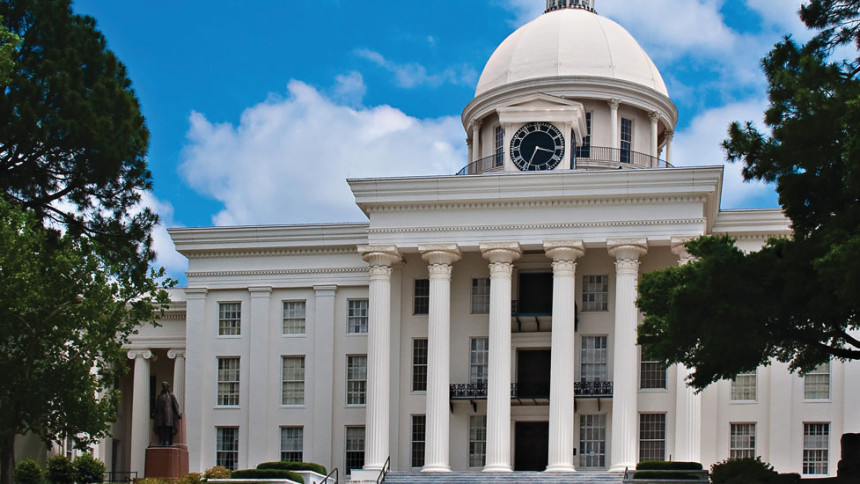| “It’s not just a tour – it’s an experience” | |
| The Montgomery Civil Rights Tours include but are not limited to the following sites: | |
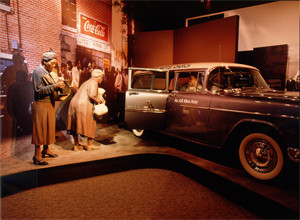 The Rosa Parks Library and Museum is located on the site where the actual arrest of Mrs. Parks took place in 1955. Inside the museum, the displays include a replica of the bus and a “real-life” simulation of what happened on that fateful day that launched the longest Boycott of a transit system in all of history. The Rosa Parks Library and Museum is located on the site where the actual arrest of Mrs. Parks took place in 1955. Inside the museum, the displays include a replica of the bus and a “real-life” simulation of what happened on that fateful day that launched the longest Boycott of a transit system in all of history. |
|
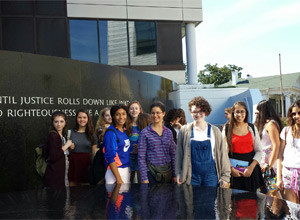 The Civil Rights Memorial & Museum displays an enthralling monument of black granite and flowing water designed by famed sculptor, Maya Lin. The monument is dedicated to 40 martyrs and events of the Civil Rights Movement. Inside the museum in a 56-seat theater, visitors will view an award winning short film produced especially for the CRMC depicting stories of this turbulent era. The Civil Rights Memorial & Museum displays an enthralling monument of black granite and flowing water designed by famed sculptor, Maya Lin. The monument is dedicated to 40 martyrs and events of the Civil Rights Movement. Inside the museum in a 56-seat theater, visitors will view an award winning short film produced especially for the CRMC depicting stories of this turbulent era. |
|
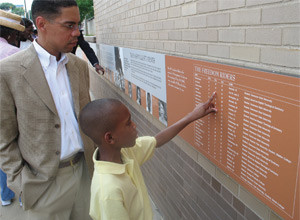 The Freedom Riders Museum (Greyhound Bus Terminal) is the site of a bloody attack on a group of freedom riders in May, 1961. The site displays an exterior exhibit of the occurrence of the violence these young men endured. Congressman John Lewis was aboard that bus along with James Zwerg, who was brutally beaten and had to be hospitalized in Montgomery. The Freedom Riders Museum (Greyhound Bus Terminal) is the site of a bloody attack on a group of freedom riders in May, 1961. The site displays an exterior exhibit of the occurrence of the violence these young men endured. Congressman John Lewis was aboard that bus along with James Zwerg, who was brutally beaten and had to be hospitalized in Montgomery. |
|
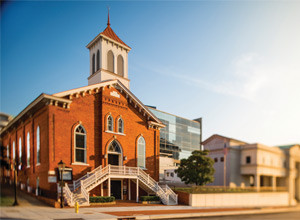 The Dexter Avenue King Memorial Baptist Church sits on the most infamous streets in Montgomery, Dexter Avenue where Reverend Dr. Martin Luther King, Jr. served as Pastor and later selected to be the spokesperson for the 1955 Montgomery Bus Boycott. The Dexter Avenue King Memorial Baptist Church sits on the most infamous streets in Montgomery, Dexter Avenue where Reverend Dr. Martin Luther King, Jr. served as Pastor and later selected to be the spokesperson for the 1955 Montgomery Bus Boycott. |
|
| The Dexter Parsonage Museum was the home where Dr. King and his family lived during his charge at Dexter Avenue Baptist Church. A marker on the front porch tells the story of the bombing of this modest house, while Mrs. Coretta King and baby Yolanda were inside. | Grassroots Sites – Contact us for these Private Tours. |
| The Tri-City Civil Rights Tours include visits to: | |
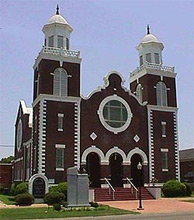 Brown Chapel A.M.E. Church – Both the building and the members of Brown Chapel AME Church played pivotal roles in the Selma, Alabama, marches that helped lead to the passage of the 1965 Voting Rights Act. The starting point for the “Selma-to-Montgomery marches”. Brown Chapel AME Church, with its imposing twin towers and Romanesque Revival styling, was built in 1908 by a black builder–of whom little is known — Mr. A.J. Farley. Brown Chapel A.M.E. Church – Both the building and the members of Brown Chapel AME Church played pivotal roles in the Selma, Alabama, marches that helped lead to the passage of the 1965 Voting Rights Act. The starting point for the “Selma-to-Montgomery marches”. Brown Chapel AME Church, with its imposing twin towers and Romanesque Revival styling, was built in 1908 by a black builder–of whom little is known — Mr. A.J. Farley. |
|
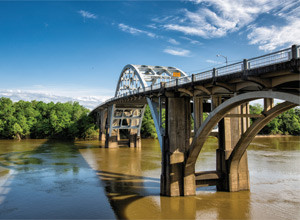 The Voting Rights Museum – Located in the Historic District of Selma, Alabama at the foot of the famous Edmund Pettus Bridge, the scene of “Bloody Sunday,” the National Voting Rights Museum & Institute is the cornerstone of the contemporary struggle for voting rights and human dignity. The Edmund Pettus Bridge became a symbol of the momentous changes taking place in Alabama, America, and the world. It was here that voting rights marchers were violently confronted by law enforcement personnel on March 7, 1965. The day became known as Bloody Sunday. Insert photo of Edmund Pettus Bridge. The Voting Rights Museum – Located in the Historic District of Selma, Alabama at the foot of the famous Edmund Pettus Bridge, the scene of “Bloody Sunday,” the National Voting Rights Museum & Institute is the cornerstone of the contemporary struggle for voting rights and human dignity. The Edmund Pettus Bridge became a symbol of the momentous changes taking place in Alabama, America, and the world. It was here that voting rights marchers were violently confronted by law enforcement personnel on March 7, 1965. The day became known as Bloody Sunday. Insert photo of Edmund Pettus Bridge. |
|
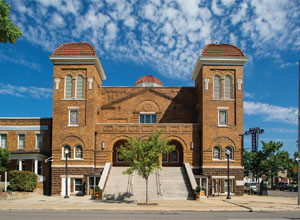 Birmingham, Alabama – You will also visit important civil rights sites such as Sixteenth Street Baptist Church and the park that was the staging ground for protest marches during the Civil Rights Movement of the 1960s. You will stand at the very spot where buildings were constructed on each corner of the street that were so tall for their day they were called skyscrapers and the location became known as the “Heaviest Corner on Earth.” Your visit will also include the Civil Rights Institute where you will see the cell where Dr. King was imprisoned when he wrote “Letter from a Birmingham Jail,” part of the museum’s Civil Rights Movement experience. Birmingham, Alabama – You will also visit important civil rights sites such as Sixteenth Street Baptist Church and the park that was the staging ground for protest marches during the Civil Rights Movement of the 1960s. You will stand at the very spot where buildings were constructed on each corner of the street that were so tall for their day they were called skyscrapers and the location became known as the “Heaviest Corner on Earth.” Your visit will also include the Civil Rights Institute where you will see the cell where Dr. King was imprisoned when he wrote “Letter from a Birmingham Jail,” part of the museum’s Civil Rights Movement experience. |
|
|
Tuskegee, Alabama – Before the first African American military pilots became known as the “Red Tails” they wore striped tails as they began their flight training in the Army’s PT-17 Stearman bi-plane. Their flying adventure started at Moton Field, in Tuskegee, Alabama, where the Army Air Corps began a military “experiment” to see if Negroes could be trained to fly combat aircraft. Come–share their adventure!! Tuskegee History Center – legendary civil rights attorney Fred Grey who represented both Rosa Parks and Martin Luther King, Jr., established the Tuskegee History Center. See how it all unfolds – from the covert civil rights activities of Booker T. Washington and the infamous Tuskegee Syphilis Study to a movement that led to the integration of various institutions. Dr. George Washington Carver’s agricultural experiments made Tuskegee Institute the best known black colleges in America. The Carver Museum features exhibits that spotlight the legacy of scientist, Dr. George Washington Carver at Tuskegee Institute. |
|
| SPECIALTY TOURS | |
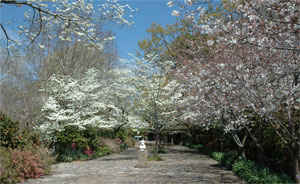 Customize Tours of Civil War sites include the First White House of the Confederacy, State Capitol and the Alabama Archives of History are available upon request.Historical and Cultural Tours – travel and visit the town of Monroeville, Alabama, where famed author Harper Lee wrote, “To Kill a Mockingbird” and once again receiving high acclaim for the newly released Best Seller, “Go Set a Watchman.” Customize Tours of Civil War sites include the First White House of the Confederacy, State Capitol and the Alabama Archives of History are available upon request.Historical and Cultural Tours – travel and visit the town of Monroeville, Alabama, where famed author Harper Lee wrote, “To Kill a Mockingbird” and once again receiving high acclaim for the newly released Best Seller, “Go Set a Watchman.”
Also available are customized Garden Tours which include The Blount Cultural Garden, Jasmine Hill Garden, Alabama Shakespeare Garden and privately-owned gardens in Montgomery. |
|
